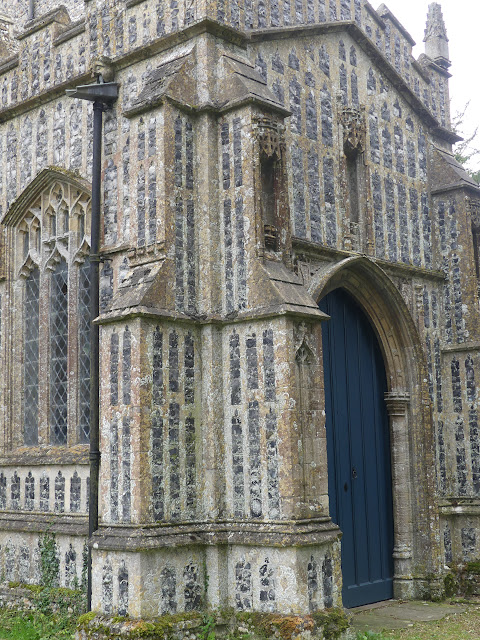This is the second church I visited last week, also a St Mary's and the village is often called Preston St Mary. Another small village in narrow lanes between Stowmarket and Lavenham.
This is another church crossed off from the 100 treasures in 100 Suffolk churches book and gets a mention because of the large and beautiful porch with it's flint flushwork dating from C16.
The church was struck by lightening in 1868 and most of the walls had to be restored with only the porch and tower as they were before
Inside the church is scaffolding for repair work on the clerestory windows. These windows hold a total of 52 heraldic shields which are a third of those collected by Robert Ryece of Preston Hall who died in 1638.
Below is a triptych with the 10 commandments, called a Decalogue. It might date back to Edward VI.
And these panels are each side of the Altar
Inside the porch the door into the church is smaller and to one side because of this altar tomb, thought to be for the porch builder.
More about the church in the Suffolk Churches Index HERE
Back Tomorrow
Sue













What an extraordinarily crafted church. Flint churches are very strange but of course that was the only building material to use. Lovely photos.
ReplyDeleteFlint churches aren't strange here! The porch is certainly special
DeleteI think that the Royal Arms of Elizabeth 1st are stunning. Still colourful after almost 500 years
ReplyDeleteSome very interesting things in this out-of-the way church
DeletePreston is a lovely church with a wonderful atmosphere.
ReplyDeleteIt's certainly interesting
DeleteAnother interesting post and it’s good to see that restoration work is in progress in the church. Catriona
ReplyDeleteSaving it for another 1,000 years perhaps
DeleteSome beautiful treasures inside this handsome church. The flint flushwork is still so crisp. I like dressed flint, it is very familiar to me from my old Surrey church while our Victorian house in the Surrey Hills had such detailing against rosy red brick. I was interested to read about the extent of the rebuilding in Victorian times after the lightning strike. Our village church here in the South Downs also fell apart in the late 19th century leaving the Medieval chancel and bell tower adrift at either end and the Victorians built a new middle with high clerestory windows and it is now a beautifully light and airy church. Those high windows always need work though! Sarah in Sussex
ReplyDeleteThe small churches without clerestory windows always seem darker now that I've been in so many that do have them
DeleteIt is a very attractive church externally with so many interesting things inside. I like the Norman font.
ReplyDeleteIt's odd that two churches in neighbouring villages both have really old fonts
DeleteThat alter tomb by the door is rather lovely
ReplyDeleteAlison in Wales x
Very unusual - I hope it was specially for the builder
DeleteThe stone and glass work is superb. The soaring arched ceilings and lovely pews looking on the the altar carries a special aura, as a church should. This is a stately beautiful church. Our churches being younger do not have the aura and atmosphere of a beautiful 16C church.
ReplyDeleteA very special church in a very small out of the way village
DeleteIt is amazing that there are still original parts standing today. I hope our little chapel lasts that long!
ReplyDeleteHopefully. I miss being able to read your blog
DeleteDid you email me for the link? If you want to try emailing me at
Deletejcnobodyiom@gmail.com I can generate the invitation for you.
Thank tou for a excellent look at a wonderful church
ReplyDeleteYou are very welcome
DeleteAn enjoyable read, you've documented well but I prefer the other St Mary's
ReplyDeleteThrilled to say we have a new Bishop! Dorrien is a lovely man, a devout Christian, and will put the diocese in a safe pair of hands.
Thanks for the visit to the church. I love the flint stonework. It's beautiful.
ReplyDeleteGorgeous church. I just love the blue door and that fount is gorgeous.
ReplyDeleteGod bless.